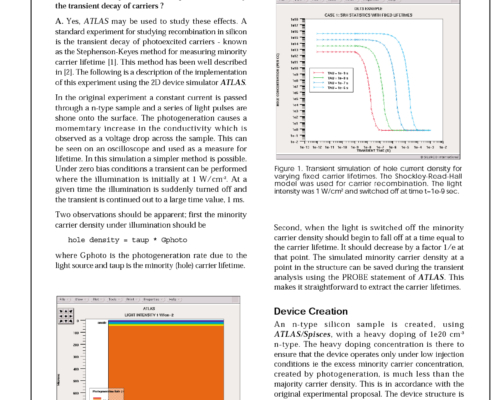
Reproducing Basic Experiments in ATLAS to Study the Transient Decay of Carriers
ATLAS may be used to study these effects. A standard experiment for studying recombination in silicon is the transient decay of photoexcited carriers - known as the Stephenson-Keyes method for measuring minority carrier lifetime [1]. This method has been well described in [2]. The following is a description of the implementation of this experiment using the 2D device simulator ATLAS.
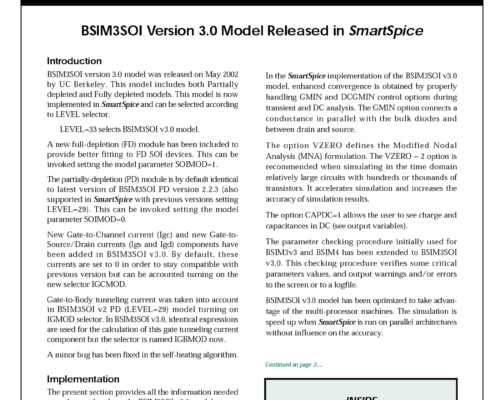
BSIM3SOI Version 3.0 Model Released in SmartSpice
BSIM3SOI version 3.0 model was released on May 2002 by UC Berkeley. This model includes both Partially and Fully depleted models. This model is now implemented in SmartSpice and can be selected according to LEVEL selector.
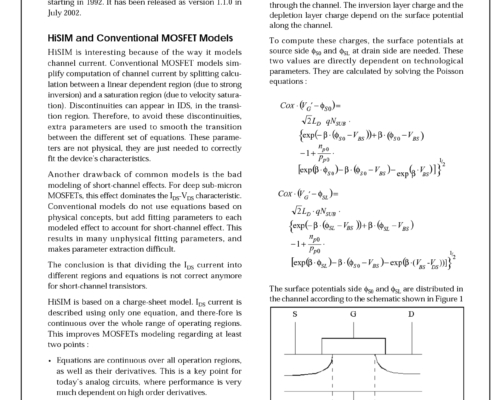
A New Surface-Potentials Based MOSFET Model: HiSIM
HiSIM is based on a charge-sheet model. IDS current is described using only one equation, and there-fore is continuous over the whole range of operating regions. This improves MOSFETs modeling regarding at least two points. Equations are continuous over all operation regions, as well as their derivatives. This is a key point for today’s analog circuits, where performance is very much dependent on high order derivatives. Parameter number is dramatically reduced (by a factor 5) for the same level of accuracy. Parameters are not interdependent anymore, making extraction easier. Furthermore, a set of parameters is valid for all channel lengths.
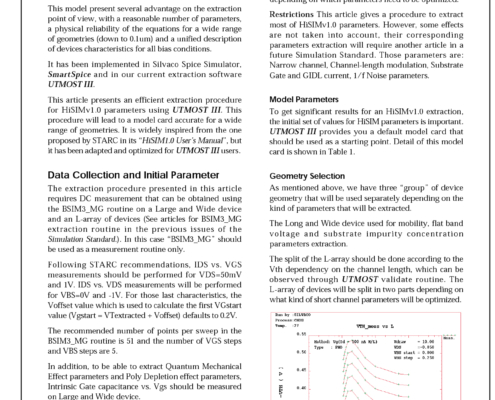
HiSIM Version 1.0 Model Released in UTMOST III
HiSIM is a MOSFET model for SPICE circuit simulation that has been developed by Hiroshima University and STARC Company. This model present several advantage on the extraction point of view, with a reasonable number of parameters, a physical reliability of the equations for a wide range of geometries (down to 0.1um) and a unified description of devices characteristics for all bias conditions. It has been implemented in Silvaco Spice Simulator, SmartSpice and in our current extraction software UTMOST III.
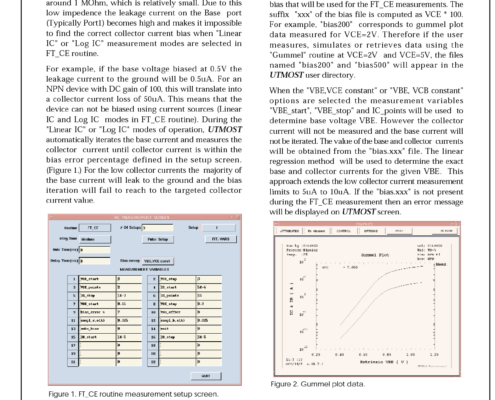
Measure Low Current FT in Bipolar devices
The input impedence of most network analyzers are around 1 MOhm, which is relatively small. Due to this low impedence the leakage current on the Base port (Typically Port1) becames high and makes it impossible to find the correct collector current bias when "Linear IC" or "Log IC" measurement modes are selected in FT_CE routine.
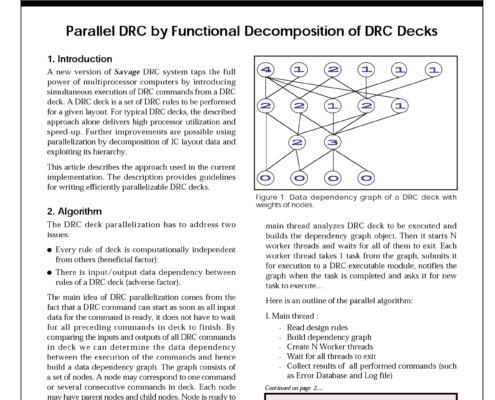
Parallel DRC by Functional Decomposition of DRC Decks
A new version of Savage DRC system taps the full power of multiprocessor computers by introducing simultaneous execution of DRC commands from a DRC deck. A DRC deck is a set of DRC rules to be performed for a given layout. For typical DRC decks, the described approach alone delivers high processor utilization and speed-up. Further improvements are possible using parallelization by decomposition of IC layout data and exploiting its hierarchy.
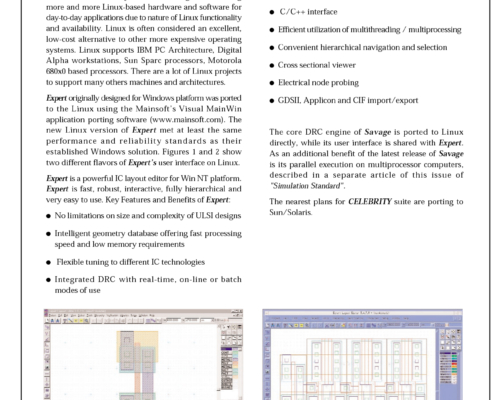
Expert Layout Editor, Savage DRC System and Guardian LVS for Linux Platform
Silvaco Data Systems announces the release of CELEBRITY CAD suite: Expert layout editor, Savage DRC system and Guardian LVS for Linux platform.
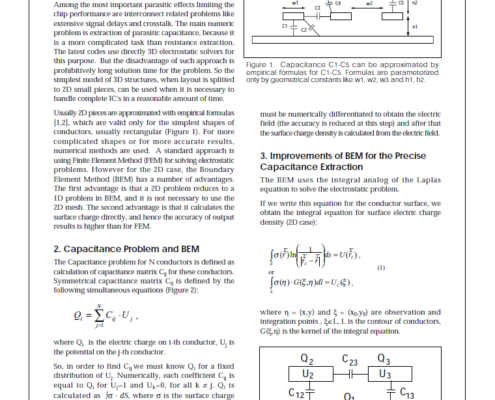
Modification of BEM for Precise Capacitance Extraction
It is well-known that parasitic effects are no longer negligible for modern integrated circuit technology. Among the most important parasitic effects limiting the chip performance are interconnect related problems like extensive signal delays and crosstalk. The main numeric problem is extraction of parasitic capacitance, because it is a more complicated task than resistance extraction. The latest codes use directly 3D electrostatic solvers for this purpose. But the disadvantage of such approach is prohibitively long solution time for the problem. So the simplest model of 3D structures, when layout is splitted to 2D small pieces, can be used when it is necessary to handle complete IC's in a reasonable amount of time.
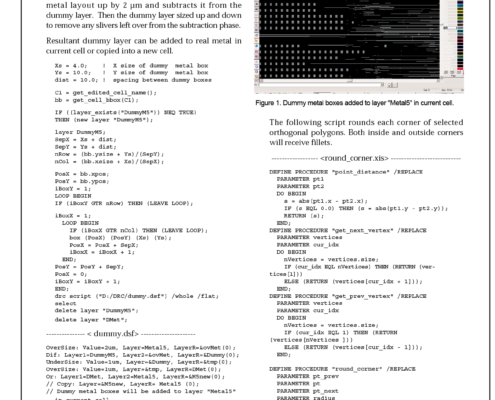
Advanced Layout Editing Using XI-scripts
To provide uniform etching of metal, dummy metal rectangles can be placed over an unused area of the chip. The following script generates dummy layer with a full array of metal rectangles over the whole cell area. It calls DRC script which sizes the real metal layout up by 2 µm and subtracts it from the dummy layer. Then the dummy layer sized up and down to remove any slivers left over from the subtraction phase.
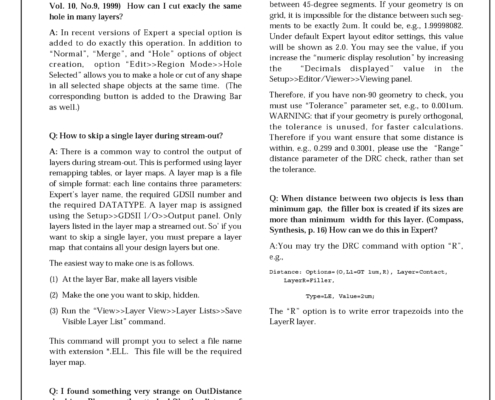
Hints, Tips, and Solutions for Expert Layout Editor
Q: How can I cut exactly the same hole in many layers?
Q: How to skip a single layer during stream-out?
Q: How to do filler boxes in Expert?
